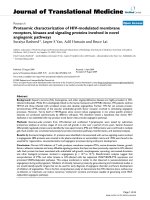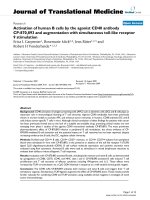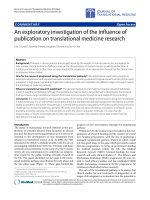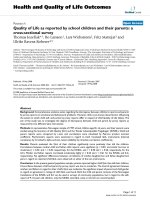Báo cáo hóa học: " New Colloidal Lithographic Nanopatterns Fabricated by Combining Pre-Heating and Reactive Ion Etching" pot
Bạn đang xem bản rút gọn của tài liệu. Xem và tải ngay bản đầy đủ của tài liệu tại đây (321.34 KB, 5 trang )
NANO EXPRESS
New Colloidal Lithographic Nanopatterns Fabricated
by Combining Pre-Heating and Reactive Ion Etching
Chunxiao Cong Æ William Chandra Junus Æ
Zexiang Shen Æ Ting Yu
Received: 26 May 2009 / Accepted: 17 July 2009 / Published online: 28 July 2009
Ó to the authors 2009
Abstract We report a low-cost and simple method for
fabrication of nonspherical colloidal lithographic nano-
patterns with a long-range order by preheating and oxygen
reactive ion etching of monolayer and double-layer poly-
styrene spheres. This strategy allows excellent control of
size and morphology of the colloidal particles and expands
the applications of the colloidal patterns as templates for
preparing ordered functional nanostructure arrays. For the
first time, various unique nanostructures with long-range
order, including network structures with tunable neck
length and width, hexagonal-shaped, and rectangular-
shaped arrays as well as size tunable nanohole arrays, were
fabricated by this route. Promising potentials of such
unique periodic nanostructures in various fields, such as
photonic crystals, catalysts, templates for deposition, and
masks for etching, are naturally expected.
Keywords Nanosphere lithography Á Nanopatterns Á
Reactive ion etching Á Preheating Á Nonspherical Á
Nonclose-packed
Introduction
Assembling colloidal micro/nano particles into 2-dimen-
sional (2D) or 3-dimensional (3D) ordered arrangements
has been of considerable importance in potential applica-
tions to biochips and biosensors [1–3], chemical sensors,
optical and electronic devices [4], photonic crystals and
suface wettability [5, 6], and as templates for designed
nanostructures for magnetic data storage memory bits, and
surface-enhanced Raman scattering substrates, etc. [7, 8].
A variety of nanofabrication technologies have been
developed to prepare large-area 2D or 3D colloidal pat-
terned surfaces, such as self-assembly, spincoating, elec-
tric-field-induced electrokinetic flowing, and Langmuir-
Blodgett deposition [9–14]. In particular, self-assembly
technique, which forming ordered periodic arrays of
packed spherical configuration with uniformly sized
microspheres, has been applied widely because of its
unique features: it is inexpensive, inherently parallel, and
enables high-throughput nanofabrication. The template
formed by the self-assembly of monodisperse nanospheres
on flat surfaces can be used as an etching/deposition mask
to fabricate a periodic array of nanosized particles with a
technique known as nanosphere lithography (NSL). How-
ever, self-assembly alone is greatly restricted to the for-
mation of close-packed spherical pattern. Therefore, one
disadvantage of NSL is its limited pattern design. Only
triangular-shaped metal nanoparticles can be directly
obtained from deposition through monolayer and double
layer of close-packed nanospheres.
To extend the limited patterns of NSL, one method is
shadow NSL, which is a combination of monolayer-prep-
aration of PS spheres with tilted shadow evaporation [15,
16], the other one is to change the colloidal patterns. In
recent years, reactive ion (plasma) etching (RIE) has been
widely used to extend the close-packed spherical colloidal
patterns based on self-assembly into nonclose-packed
nonspherical patterns. It becomes more challenging to
fabricate nonspherical particles with controllable shapes,
nonclose-packed patterns, and good periodicity in a large
scale. Choi et al. [17] employed RIE technique with pure
O
2
gas or mixture of CF
4
and O
2
to create 2D and 3D
C. Cong Á W. C. Junus Á Z. Shen Á T. Yu (&)
Division of Physics and Applied Physics, School of Physical and
Mathematical Sciences, Nanyang Technological University,
Singapore 637371, Singapore
e-mail:
123
Nanoscale Res Lett (2009) 4:1324–1328
DOI 10.1007/s11671-009-9400-0
nonspherical polystyrene (PS) particle arrays of various
shapes by using PS spheres stacking layer by layer, with
the top layer acting as mask. One disadvantage of this
process is that the area of the arrays with a certain con-
figuration is small because there is no controllable method
to fabricate large-area of certain layers of PS spheres until
now. Tan et al. [18] and Yan et al. [19] prepared nonclose-
packed polystyrene spheres by using a gas mixture of CF
4
and low O
2
content and pure argon plasma etching process,
respectively. Only elliptical particles were obtained. Wu
et al. [20] fabricated nano-net structure with necks formed
between neighboring PS particles by oxygen plasma etch-
ing of a monolayer of PS spheres. However, the necks
disappeared when the etching time was longer than 3 min,
which leading to the uncontrollability of further manipu-
lating the dimension of this novel nano-net structure.
In this work, we demonstrate a simple and inexpensive
method to fabricate controllable nonclose-packed non-
spherical PS particle arrays with long-range order. The
method is based on a combination of colloidal self-
assembly, preheating, and oxygen reactive ion etching
techniques. The long-range ordered network pattern of PS
particle arrays with tunable neck width and length were
obtained. The hexagonal- and the rectangular-shaped PS
particles were fabricated. Moreover, the round nanoholes
were also achieved after oxygen RIE of double layer of PS
spheres with preheating. These structures and patterns
differ noticeably from the known elliptical-shaped PS
particles and triangular nanoholes produced without pre-
heating. Such unique colloidals and their ordered arrays
resulted from the strategy demonstrated in this work may
have important applications in fields of chemical sensors,
photonic crystals, catalysts, biosensors, and can serve as
good deposition or etching masks for growth of other 2-
dimensional nanostructures, which have shape- and
size-dependent properties. The effect of preheating on the
fabrication of long-range ordered nonclose-packed non-
spherical colloidal nanopatterns was also discussed in this
work.
Experimental Procedures
Monodispersed PS spheres (1,000 and 465 nm in diameter)
suspensions (2.6 wt% in water, surfactant-free) were pur-
chased from Polysciences, Inc and diluted by mixing with
an equal amount of ethanol. The Si substrates were cleaned
in an ultrasonic bath with acetone, ethanol, and deionized
water at room temperature, and then rinsed using deionized
water. A monolayer of highly ordered PS spheres were first
self-assembled on water surface using a technique reported
by Rybczynski et al. [9] as below. About 5 lL of prepared
solutions was dropped onto the surface of a 3 9 3 cm large
clean silicon wafer, which was kept in 10% dodecylsodi-
umsulfate solution for 12 h previously. The wafer was then
slowly immersed in the Ø 10 cm glass vessel filled with
deionized water and PS spheres started to form a mono-
layer on the water surface. Such monolayer was then lifted
off from the water surface using another cleaned Si sub-
strate, and dried in air at room temperature. Double-layered
PS spheres were produced by immersing dry, once-covered
substrates into water and lifted off a second layer. Then, the
as-prepared monolayer of PS spheres with diameters of 465
and 1,000 nm were put into an airtight oven and preheated
for 1 and 2 min, respectively. The airtight oven was heated
up to 110 °C before putting samples into it, which is
slightly higher than the glass transition temperature of PS
(i.e., T
g
= 100 °C, provided by the PS microsphere man-
ufacturer). Finally, the RIE process was performed by
using March PX-250 plasma etching system with power of
70 W and base pressure of 70 mTorr. Pure oxygen gas with
flow rate of 100 sccm was used as plasma source to morph
the preheated close-packed PS spheres monolayer into
arrays of various nonclose-packed nonspherical PS particle
patterns with varying RIE durations. The morphologies of
the samples were characterized by field emission scanning
electron microscopy (FE-SEM, JEOL JSM-6700F).
Results and Discussion
Figure 1b2–b4 shows the SEM micrographs of network PS
particle arrays with tunable neck width and length which
were produced after oxygen RIE of monolayer of PS
spheres with preheating. To reveal the effect of preheating,
the morphologies of PS particle arrays produced after
oxygen RIE of monolayer of PS spheres without preheating
were also shown in Fig. 1a2–a4. Here, the initial size of PS
sphere is 465 nm, and the preheating time is 1 min because
the longer duration of heating could melt the PS spheres
and merge them into a film. The PS spheres cannot be
separated from each other even after oxygen RIE. It can be
seen that the network pattern, which was composed of each
PS particle with six necks connecting to the nearest-
neighbor PS particles, was obtained by combining pre-
heating and oxygen RIE. The network pattern kept long-
range order even the etching time was as long as 700 s
(Fig. 1b4). However, for the PS particles without preheat-
ing, though there was also a neck formation between
neighboring PS particles when the etching duration was
\300 s, most of the necks disappeared when the etching
time was beyond this value (Fig. 1a3). The PS particle
arrays became disordered when the etching time was
longer than 450 s (Fig. 1a4). The loss of periodicity is
mainly due to the plasma bombardment which may knock
away the isolated tiny spheres [21]. The neck length and
Nanoscale Res Lett (2009) 4:1324–1328 1325
123
width as a function of RIE time are plotted in Fig. 2 for the
preheated series, showing that the length (or width) of the
necks increases (or decreases) linearly with the increasing
oxygen RIE time. The neck length and width can be easily
tuned from about 30 to 80 nm and 150 to 80 nm, respec-
tively, by increasing the oxygen RIE time. It can be seen
from Fig. 1a1, b1 that the preheating leads to the contact
between neighboring PS particles changing from point
contact to face contact, and preheating also makes the PS
particles stick tightly on the substrate. Correspondingly, the
PS particles with preheating connect each other tighter than
those without preheating, thus they can keep long-range
order even when the etching time was as long as 700 s. The
controllable necks between adjacent PS particles are
formed by anisotropic RIE of the joint of the face contact.
Therefore, the formation of long-range ordered network
pattern with tunable neck width and length can be attrib-
uted to anisotropic RIE and preheating, which converts the
point contact between original spheres (see Fig. 1a1) into
extended face contact between regular polygons (see
Fig. 1b1), as well as makes the PS spheres stick tightly to
the substrate. Therefore, preheating plays a very important
role not only in fabricating this new controllable network
pattern but also in keeping long-range order.
Figure 3 shows the rectangular-shaped PS particle
arrays fabricated by oxygen RIE of inhomogeneous den-
sified monolayer of PS spheres with 465 nm in diameter.
Rodlike shape of the apertures are formed in the inhomo-
geneous densified colloidal monolayer after preheating for
1 min (Fig. 3a), which differs noticeably from the trian-
gular apertures formed in the standard PS spheres mono-
layer. The formation mechanism of the rodlike shaped
apertures has been discussed in Ref. [22] in detail. The PS
particles in the inhomogeneous densified arrays have been
deformed to quasi-rectangular shape from spherical shape
by preheating. Consequently, if the preheated inhomoge-
neous densified colloidal monolayer was subsequently
oxygen reactive ion etched, the morphology of the mono-
layer evolved into different ordered arrays with rectangu-
lar-shaped PS particles because of the anisotropic property
of RIE. When the preheated sample was etched for 600 s,
the shape of PS particles was changed to rectangular par-
ticles with four necks linked with four of its neighboring
particles. As a result, the morphology of the monolayer was
converted to network-like arrays with rectangular-shaped
PS particles (Fig. 3b). When the etching time was
increased to 900 s, the size of the rectangular-shaped PS
particles was decreased and the necks were broken.
Therefore, the morphology of the monolayer was changed
to PS arrays consisting of separated rectangular-shaped
particles (Fig. 3c). All of these rectangular-shaped PS
particle arrays, exhibiting a hexagonal arrangement like
that of the pristine monolayer, are new colloidal litho-
graphic nanopatterns firstly reported here.
Fig. 1 SEM images of the PS particle monolayer (465 nm in
diameter) after oxygen RIE for different time: a1–a4 0, 300, 450,
600 s, without preheating; and b1–b4 0, 300, 450, 700 s, with
preheating, respectively. The scale bar is 500 nm in each image
Fig. 2 Plot of a neck length, and b neck width of the necks formed in
the preheated monolayer of PS spheres (465 nm in diameter) as a
function of oxygen RIE time
1326 Nanoscale Res Lett (2009) 4:1324–1328
123
Figure 4 shows another new type of colloidal nanopat-
terns: hexagonal-shaped PS particle arrays fabricated by
preheating and oxygen RIE of self-assembled monolayer of
1,000 nm PS spheres. After exposure to the same oxygen
RIE conditions for 30 min, the morphology of the pre-
heated monolayer with face contact between neighboring
spheres (Fig. 4b1) was converted to hexagonal-shaped PS
particle arrays arranged hexagonally with long-range order
(Fig. 4b2), which is very different from disordered ellip-
tical-shaped PS particle pattern (Fig. 4a2) obtained from
the nonpreheated sample with point contact between
neighboring spheres (Fig. 4a1). Therefore, preheating,
which deforms the contact between neighboring PS parti-
cles from point contact to face contact, is critical in the
formation of this new colloidal nanopatterns of hexagonal-
shaped PS particle arrays.
Our method can be extended to a double-layer of PS
spheres to change the colloidal nanopatterns, as shown in
Fig. 5. Different morphologies of colloid crystals were
Fig. 3 SEM images of preheated inhomogeneous densified mono-
layer of PS spheres with 465 nm in diameter after oxygen RIE for
different time: a 0s,b 600 s, c 900 s, respectively. The scale bar is
500 nm in each image
Fig. 4 SEM images of monolayer of PS spheres (1,000 nm in
diameter): a1,b1 before and after preheating; a2,b2 after the same
oxygen RIE conditions for the nonpreheated sample and preheated
sample, respectively. The scale bar is 1,000 nm in each image
Fig. 5 SEM images of double-layer of PS spheres (1,000 nm in
diameter) after the same oxygen RIE conditions with different
preheating time: a 0 min, b 1 min, c 3 min, respectively. The scale
bar is 1,000 nm in each image
Nanoscale Res Lett (2009) 4:1324–1328 1327
123
produced by oxygen RIE of the double-layer of PS spheres
(1,000 nm in diameter) preheated for different durations of
0, 1, and 3 min. Compared with the resulting shape of
colloidal monolayer without preheating (Fig. 5a), the shape
of the apertures changed gradually from triangle to round,
and the size of the apertures became smaller and smaller by
increasing the preheating time (Fig. 5b, c). These scale-
down nanohole arrays are good masks for fabrication of
nanodot arrays of other materials.
Conclusions
In summary, we have fabricated controllable PS particle
structures with a long-range order by combination of pre-
heating and oxygen RIE techniques. The neck length and
neck width of the network pattern fabricated by oxygen
RIE of preheated monolayer of PS spheres can be easily
tuned from about 30 to 80 nm and 150 to 80 nm, respec-
tively, by increasing the oxygen RIE time. Moreover, the
hexagonal-shaped and rectangular-shaped PS particles and
round nanoholes were obtained after oxygen RIE of
monolayer and double layer of PS spheres with preheating,
which differs noticeably from the elliptical-shaped PS
particles and triangular nanoholes produced without pre-
heating. The network pattern with controllable neck width
and length and the hexagonal-shaped as well as rectangu-
lar-shaped PS particle arrays obtained with preheating are
new colloidal lithographic nanopatterns, which raised
hopes for NSL. Preheating plays a crucial role in fabri-
cating these new long-range ordered PS particle arrays.
These new colloidal nanopatterns have important applica-
tions in fields of catalysts, biosensors, and biomedical
devices, especially in next-generation integrated nanopho-
tonic devices, bimolecular labeling and identification [23].
References
1. J. Storhoff, R. Elghanian, R.C. Micuc, C.A. Mirkin, R.L.
Letsinger, J. Am. Chem. Soc. 120, 1959 (1998)
2. C. Hagleitner, A. Hierlemann, D. Lange, A. Kummer, N. Kern-
ess, O. Brand, H. Baltes, Nature 414, 293 (2001)
3. Y. Cui, Q.Q. Wei, H.K. Park, C.M. Leiber, Science 293, 1289
(2001)
4. Y. Xia, E. Kim, X.M. Zhao, J.A. Rogers, M. Prentiss, G.M.
Whitesides, Science 273, 347 (1996)
5. Z. Liu, Z. Xie, X. Zhao, Z.Z. Gu, J. Mater. Chem. 18, 3309
(2008)
6. Z.Z. Gu, H. Uetsuka, K. Takahashi, R. Nakajima, H. Onishi, A.
Fujishima, O. Sato, Angew. Chem. Int. Ed. 42, 894 (2003)
7. J.R. Jeong, S. Kim, S.H. Kim, J.A.C. Bland, S.C. Shin, S.M.
Yang, Small 3, 1529 (2007)
8. J. Aizpurua, P. Hanarp, D.S. Sutherland, M. Ka
¨
ll, G.W. Bryant,
F.J.G. de Abajo, Phys. Rev. Lett. 90, 057401 (2003)
9. J. Rybczynski, U. Ebels, M. Giersig, Colloids Surf. A Physico-
chem. Eng. Asp. 219, 1 (2003)
10. Y. Xia, B. Gates, Y. Yin, Y. Lu, Adv. Mater. 12, 693 (2000)
11. P. Jiang, T. Prasad, M.J. McFarland, V.L. Colvin, Appl. Phys.
Lett. 89, 011908 (2006)
12. M. Trau, D.A. Saville, I.A. Aksay, Science 272, 706 (1996)
13. S.O. Lumsdon, E.W. Kaler, J.P. Williams, O.D. Velev, Appl.
Phys. Lett. 82, 949 (2003)
14. S. Reculusa, S. Ravaine, Chem. Mater. 15, 598 (2003)
15. J. Rybczynski, U. Ebels, M. Giersig, Colloids Surf. A 219,1
(2003)
16. M.C. Gwinner, E. Koroknay, L. Fu, P. Patoka, W. Kandulski, M.
Giersig, H. Giessen, Small 5, 400 (2009)
17. D.G. Choi, H.K. Yu, S.G. Jang, S.M. Yang, J. Am. Chem. Soc.
126, 7019 (2004)
18. B.J.Y. Tan, C.H. Sow, K.Y. Lim, F.C. Cheong, G.L. Chong,
A.T.S. Wee, C.K. Ong, J. Phys. Chem. B 108, 18575 (2004)
19. L. Yan, K. Wang, J. Wu, L. Ye, J. Phys. Chem. B 110, 11241
(2006)
20. P. Wu, L. Peng, X. Tuo, X. Wang, J. Yuan, Nanotechnology 16,
1693 (2005)
21. H. Li, J. Low, K.S. Brown, N. Wu, IEEE Sens. J. 8, 880 (2008)
22. A. Kosiored, W. Kandulski, H. Glaczynska, M. Giersig, Small 1,
439 (2005)
23. F.Q. Sun, W.P. Cai, Y. Li, B.Q. Cao, Y. Lei, L.D. Zhang, Adv.
Funct. Mater. 14, 283 (2004)
1328 Nanoscale Res Lett (2009) 4:1324–1328
123









